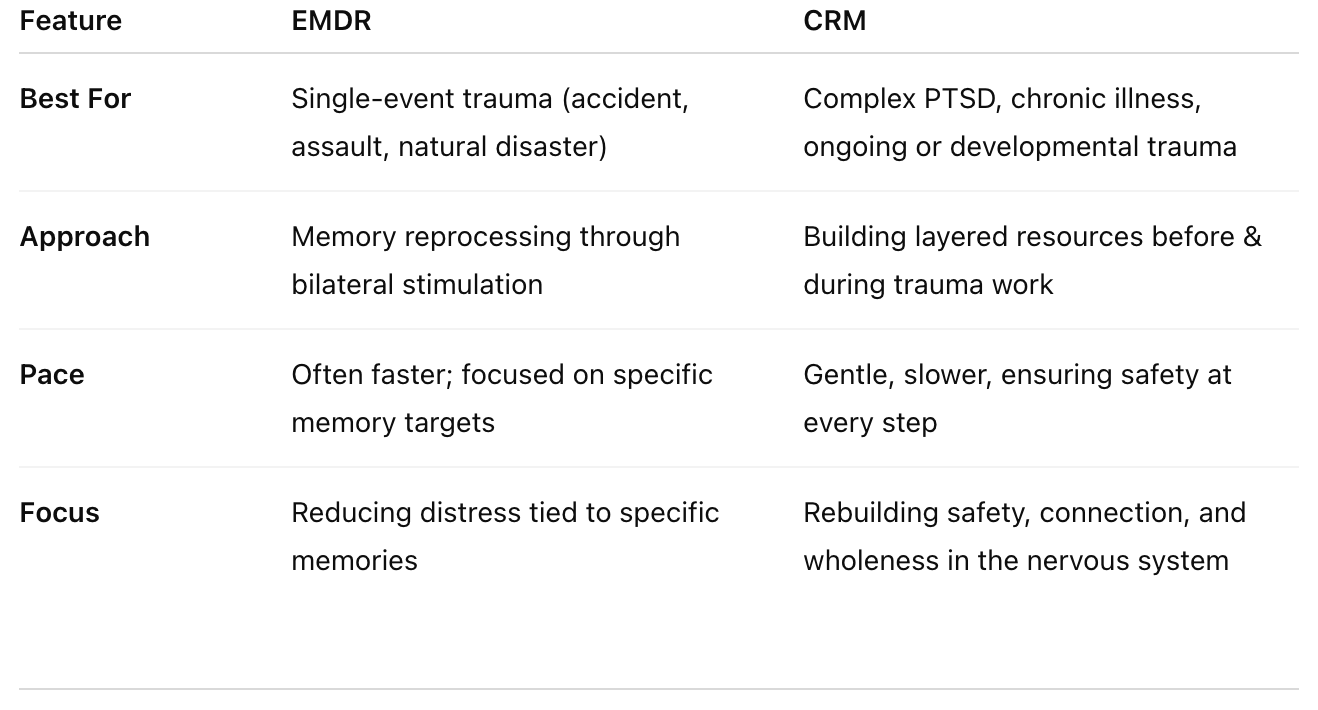CRM vs. EMDR: Which Trauma Therapy Is Right for You?
Why Choosing the Right Trauma Therapy Matters
If you’ve been exploring therapy options for trauma, you may have come across two powerful methods: EMDR (Eye Movement Desensitization and Reprocessing) and CRM (The Comprehensive Resource Model).
Both are effective, research-backed approaches for trauma healing—but they’re not one-size-fits-all. The right method for you often depends on the type of trauma you’ve experienced, the symptoms you’re facing, and the pace your nervous system can tolerate.
Let’s break down what each one does best—so you can feel clearer about which path might support your healing journey.
What Is EMDR?
Eye Movement Desensitization and Reprocessing (EMDR) is one of the most widely used trauma therapies in the world. It works by helping your brain reprocess disturbing memories so they no longer feel overwhelming in the present.
Originally developed for PTSD
Uses bilateral stimulation (eye movements, tapping, or sounds) to help “unstick” traumatic memories
Allows the memory to be stored in a less emotionally charged way
Especially helpful when trauma is tied to a specific event (like an accident, assault, or medical emergency)
For example: If you were in a car accident and now panic every time you drive, EMDR can help you revisit that memory safely, so it no longer triggers intense fear. Or if you have a fear of flying and are going on a trip soon, EMDR can help you to decrease sensations of anxiety and panic.
What Is CRM?
The Comprehensive Resource Model (CRM) is a newer trauma therapy designed specifically for people with complex PTSD, ongoing trauma, or chronic patterns rooted in early experiences.
Unlike EMDR, which often targets a single event, CRM focuses on building layers of safety and internal resources before and during trauma processing.
Ideal for those with long-term or developmental trauma
Uses somatic (body-based), attachment-focused, and spiritual resources to anchor safety
Works gently, so the nervous system doesn’t become overwhelmed
Helps clients feel safe enough to stay present while processing painful memories
For example: If you grew up in an environment of emotional neglect, chronic stress, or repeated traumatic events, CRM offers a slower, more resourced approach to healing.
CRM vs EMDR: Key Differences
Both modalities are extremely beneficial in decreasing activation and stress associated with traumatic events.
EMDR is often best for single-incident trauma
CRM is designed for complex, layered, or ongoing trauma
Which One Is Right for You?
Ask yourself:
Did your trauma come from one major event? EMDR may be a good fit.
Did your trauma develop over years of ongoing stress or repeated experiences? CRM may be more supportive.
Of course, many people experience both—a traumatic event layered on top of earlier pain. In those cases, therapy may draw from elements of each approach depending on what feels safe and effective for your system.
The Bottom Line
Both EMDR and CRM can be powerful tools for healing—but the right one for you depends on your story, your nervous system, and your needs.
If you’ve felt like other therapies haven’t fully reached the root of your pain, CRM may offer the depth and safety you’ve been missing. If your struggles are tied to a specific event that still feels raw, EMDR may help free you from that memory’s grip.
You don’t have to figure it out alone. As a trauma-informed therapist, I can help guide you toward the approach that makes the most sense for you.
Celeste Tomasulo, LMFT

